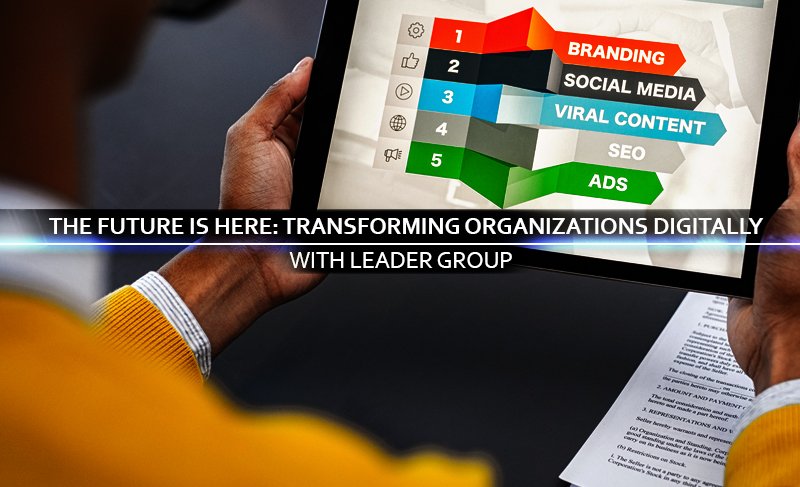
The Future is here: Transforming organizations Digitally with Leader Group
“Digital transformation in organizations not only increases the efficiency and cuts the costs but also promotes a culture of the digital organization that eases the business processes. Leader Group’s Digital transformation Services ensures a complete transition from non-digital to digital, allowing businesses to reap the benefits of digitization”.
The world has changed, and so are the ways of doing business.
The earlier traditional ways of carrying out business processes are no longer the trend now; with digital transformation chipping in and changing its ways.
Along with the rise in digitization, the industrial world is facing rapidly changing challenges due to digitization.
We have limited resources. Also the recent COVID-19 pandemic has pushed us to do more with less.
Digitalization and automation are the answers to meet these challenges of the pandemic on its way to Industry 4.0; it has become essential to understand the massive amount of data created in the Industrial Internet of Things (IoT).
Organizations are exactly focusing
on this by leveraging digital transition by combining the real and the digital worlds using the infinite amount of data allowing the finite resources efficiently by enabling a more sustainable and efficient business environment.
According to recently conducted research, the global market size of digital transformation will reach USD 1200 Billion by 2026.
This massive increase in digital transformation’s market value results from the rising need for digitized business processes.
Factors such as increasing spending on digital marketing and advertising activities by the organizations and changing business models drive digital transformation among businesses.
Transforming Organizations Digitally:
In Industry 4.0, the investments and approaches increase the levels of competitiveness of companies once they enable new levers of competitive advantage and therefore takes necessary actions to have a strategic vision that identifies the latest products and services offered to the market and the related business models to avoid investments and generate market value for digital footprint.
In achieving a seamless integration of digital transformation services, it is also necessary to be aware of the strategic; organizational, and cultural levers enabling organizations with digitization.
Furthermore, several digital tools and technologies are chosen to create more business leverage and avoid low investments return; thereby promoting digitally-enabled services to the masses.
Organizations observe the below mentioned transitions while they opt for digital transformation.
Business Model Evolution:
Change in BCPs (Business Continuity plans); organizational business terms and conditions, policies, and guidelines leads to a digital business model that not only promotes digital transformation among businesses but also leads to a strategic digital evolution necessary for businesses to evolve and flourish.
Digitization of Downstream Processes:
Digital platforms are a medium to promote digitization among businesses.
From creating digital awareness to adding value proposition to business processes; digitizing downstream processes such as maintaining business relations and transactions with customers allows the activation of new businesses associated with pre-existing ones.
Digitization of Upstream Processes:
No business gets digital unless its upstream processes, too, are digitized.
This represents a higher level of relationship with the market and customer.
This raises the possibility of the customers directly managing the upstream dimensions and selling it to the customers who intend to benefit from digitized services.
Re-inventing New Business Models:
Existing business models, sometimes, do not suffice to add value to digitization-based processes.
The previous identification of new business gets linked to the current activities carried out by the company in its ecosystem or to existing ones.
Moreover, it creates more value connected to the existing ones, re-inventing the new business models.
Designing new businesses:
It is sometimes not easier to mold the business processes, policies, and guidelines to leverage a new business model; therefore, it also becomes imperative to utilize the existing business processes and deliver growth, resilience, and digital business enterprise.
The first requirement is to have a business structure integral into the existing business ecosystem and promote digitization.
Leader Group diligently understands these business requirements and helps its clients utilize digital transformation services and promote digitization among businesses.
Its digital transformation services are one-of-its-kind that create new business models and modify the existing business processes, culture, and customer experiences to meet changing business and market requirements and digital transformation to the companies.
It follows a three-pronged People, Processes, and Technology approach that takes care of the organization’s internal and external needs.
These processes help businesses achieve digital transformation by accommodating changing companies’ requirements and promoting a digital version of business practices with a fusion of online, offline, and radical digitization of businesses.
Conclusion:
In conclusion, digital is not only limited to more significant enterprises.
Still, it is also moving ahead with the digitization of mid-size businesses.
Digital and businesses go hand in hand where the business processes are taken care of by leveraging the existing business processes along with new business processes and achieving digitization.
In the days to come; digital business scenarios will only flourish with companies utilizing digital business processes and bringing in digital transformation.





